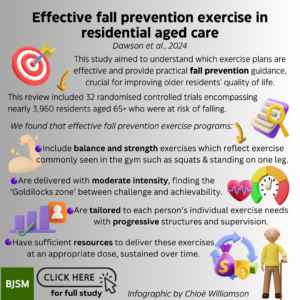Authors: Rik Dawson, Jenni Suen, Catherine Sherrington, Wing Kwok, Marina B Pinheiro, Abby Haynes, Charlotte McLennan, Katy Sutcliffe, Dylan Kneale and Suzanne Dyer.
Why is this Study Important?
As we age, our chance of falling increases, potentially leading to serious issues like fractures, loss of independence, and even death. For older adults living at home, it’s well-known that exercise can reduce falls, especially balance exercises and functional activities mimicking daily movements, such as stepping or standing up from a chair, typically prescribed by professionals like physiotherapists. However, it’s unclear if these exercises prevent falls in nursing homes or aged care homes, and what form they should take. A 2018 Cochrane Review couldn’t give clear advice due to insufficient and varied study results, complicating fall prevention efforts for aged care residents.
Our study closely examines previous research on exercise programs in aged care homes, offering detailed insights into different exercise methods, their implementation, and relevant contextual factors. The aim is to understand which exercise plans are effective and provide practical fall prevention guidance, crucial for improving older residents’ quality of life.
How Did the Study Go About This?
We conducted an Intervention Component Analysis of randomised controlled trials that were identified by updating a 2018 updated Cochrane review of exercise interventions in residential aged care homes. The review included 32 randomised controlled trials encompassing nearly 3,960 residents aged 65+ who were at risk of falling and often had cognitive or mobility impairments.
Our study examined these trials to identify what components make exercise interventions effective in preventing falls in aged care homes. We analysed the data to pinpoint key features that were likely to have contributed to either positive or negative outcomes.
What Did the Study Find?
We found that effective fall prevention exercise programs share some common features. They:
- Include balance and strength exercises which reflect exercise commonly seen in the gym such as squats, leg lifts and standing on one leg. Generally, the person starts without weight and then progresses to using leg weights or resistance bands.
- Are delivered with moderate intensity, finding the ‘Goldilocks zone’ between challenge and achievability.
- Are tailored to each person’s individual exercise needs with progressive structures and supervision to ensure participants perform them correctly and safely.
- Have sufficient resources to deliver these exercises at an appropriate dose, sustained over time.
We found that when exercise programs in aged care homes incorporate these features, they are much more likely to succeed in preventing falls.
What are the Key Take-Home Points?
This study sheds light on how fall prevention exercise programs can be optimised in aged care homes. By focusing on tailored balance and strength exercises delivered at moderate intensity, and ensuring the programs are progressively structured, supervised, and well-resourced, we can significantly reduce the risk of falls. This guidance not only helps in the current implementation of fall prevention programs but also paves the way for further research, including large clinical trials which are needed to validate these findings.
In summary, if we can get the right kind of exercise, delivered correctly and adequately in aged care homes, we have the potential to make a significant difference in the lives of older adults by preventing falls and thus improving their overall quality of life.
